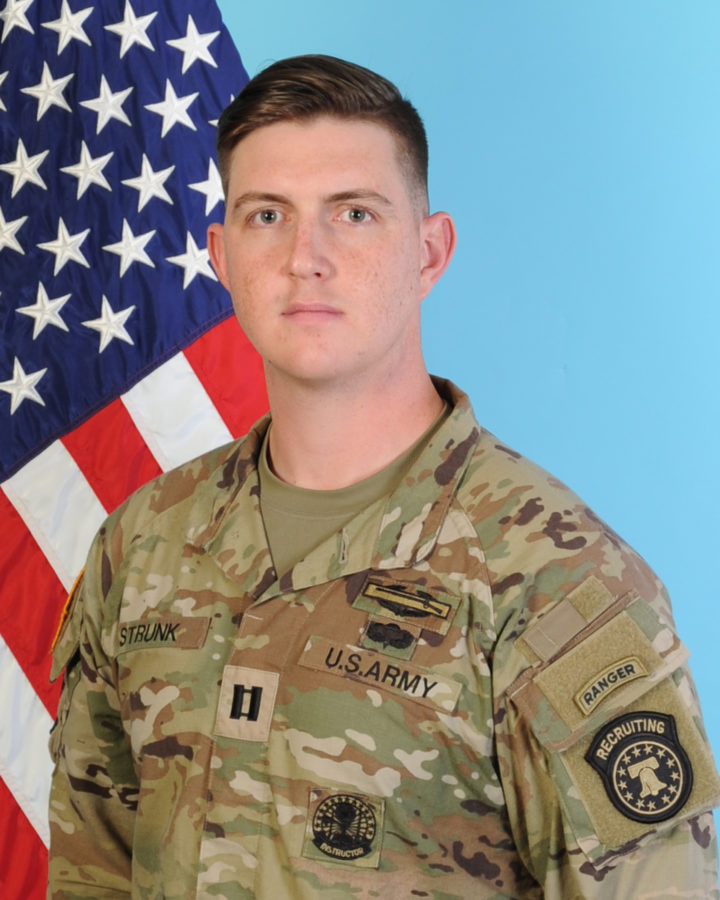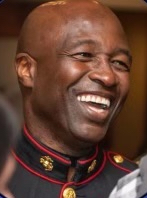This year’s class of area high school graduates will be faced with the decision about what to do next. Some will head straight into college, while others will begin trade programs or entry-level jobs.
Only a fraction of today’s youths will choose to enlist in one of the six branches that make up the U.S. armed forces. While military enlistment has long been considered a patriotic and meaningful means of employment and education, national reports indicate that all branches of the military have experienced declining enlistment in recent years.
During a Senate subcommittee budget hearing held April 19 on military readiness for fiscal year 2024, leaders from the Army and Air Force estimated they’ll miss their recruitment goals by 10,000 each, while representatives from the Navy said they expected to be 6,000 sailors short.
That trend has played out in Western North Carolina as well, says Army Capt. Casey Strunk, who serves as the company commander for the Asheville Army Recruiting Company.
“The situation nationally has been spoken to at this point,” says Strunk. “We’re definitely down on numbers.”
But the latest data from the local Army recruiting offices offers hope. Strunk notes that May represented the first 30-day period in which the local office met its monthly goal of 24 new recruits since fiscal year 2019-20.
“We were able to achieve [our goal] 100%, which is what we call a ‘mission accomplishment,’” says Strunk.
While the armed services are still grappling with a variety of issues that have led to fewer enlistments overall, Strunk notes that the success of WNC’s local offices could soon be reflected throughout the country.
“[Meeting our goal] was phenomenal for the company, and that is very [representative] of the Army as a whole.”
A range of factors
Military enlistment has dropped nationally in recent years for a variety of reasons, including societal changes, internal processes and fewer eligible candidates. Strunk points out that a majority of Americans of ideal recruiting age, which ranges from 17-39 depending on the branch of service, are simply unqualified for service due to weight, drug use or other health issues, or the ability to meet academic requirements. Strunk estimates that only 23% of people in that target age range are fully eligible to serve in the Army and Army Reserve. That’s down from 29% of eligible adults in fiscal year 2019, according to data from the U.S. Army Recruiting Command.
“We do recruiting in Western North Carolina, so we have stations in Morganton, Hickory, Asheville, Shelby, Sylva and Hendersonville,” says Strunk, who has served in the Army for six years. “And across the country, that propensity and eligibility for enlistment really varies geographically where you are and by who has health care available to them and who has higher education options available.”

He adds that a new health record database implemented servicewide last year is also contributing to lower enlistment numbers. He acknowledges that the new system, called Military Health System Genesis, provides some benefits, such as offering a thorough medical and mental health history for applicants. But gathering all of that data slows down the enlistment process.
“Before this new medical program came out, you could theoretically prospect, recruit and then enlist someone into the Army within two to four weeks,” he explains. “And that timeline is pretty much shot now. “
Strunk also notes that before the COVID-19 pandemic in 2020, the WNC recruiting offices frequently met their recruitment targets. Those numbers began to drop, however, when in-person recruitment came to a standstill.
Air Force Tech. Sgt. Zachary Ohmie, a recruiter in the U.S. Air Force and Space Force office in Asheville, echoes those concerns, saying that the interaction between recruiters and students in his office was limited to virtual visits.
“It has been a bit of a struggle getting our name out there and getting these younger people interested in the Air Force or in the military in general,” says Ohmie, who has been in the Air Force for 14 years and has served as a recruiter for the last two years. “Not getting into schools and talking to kids face to face definitely hurt us.”
Declining visibility
Even without the limitations brought on by the pandemic, Ohmie says the nation’s dwindling veteran population and their influence on future generations is playing a role.
“I think that it ties back to fewer people that have relatives or family members who have served or that are currently serving,” says Ohmie. “Because the military has gotten a little bit smaller over time, that exposure to younger people [through] family members [who have] served, is getting smaller as that footprint gets smaller.”
Without that firsthand knowledge from friends or family members, Ohmie says, that can fuel the misconception that the military service men and women work exclusively in combat roles, which he says represents only a portion of military careers.
“There’s a lot of people who are worried about being placed in harm’s way, but for the most part, the Air Force serves a support role, so most of us have jobs that are outside of combat,” Ohmie explains. “But it can be hard to get in front of enough people to get that message out there.”
“The Army has a lot to offer, and it’s not about necessarily enlisting and getting shipped off somewhere,” adds Strunk.
Both Ohmie and Strunk say that in addition to offering positions in the ground forces or as pilots, the military offers more than 130 specialized career options that often mirror civilian jobs, such as information technology and cybersecurity, medical and nutrition, and public relations.
“We’re trying to break that stigma that being in the military is being on the front lines with a weapon, no matter what, because that’s not really the case,” Ohmie says.
The role of JROTC
With exposure to military life from family members fading, Junior Reserve Officer Training Corps training programs in high schools gave students their first taste of what military service might be like.
However, Asheville City Schools discontinued its JROTC program in 2019 after enrollment fell “below the minimum that is statutorily mandated … for consecutive years.”
Former 1st Sgt. Jesse Warren, who served in the Marine Corps for 25 years and then as a JROTC instructor within the Asheville City Schools district for 16 years, says that the skills that students learned, such as communication, leadership and discipline, helped prepare young adults to enter the military, college or any industry of their choosing.

“The JROTC program is designed to build students up and put some good fertilizer inside of them so that when they do grow, they learn and you’re going to age well,” says Warren, who now serves as a member of the Asheville City Board of Education. “It’s hard for students to become that solid person because they really don’t know how. That’s one reason why the JROTC program was important.
“The reason why people don’t go into the military is because they’re not prepared. They’re not talking to the right people,” Warren says.
While Warren emphasizes that JROTC is not a strictly military preparation program, a 2019 report from the Army Times found that 20%-25% of students who participate in the program do go on to serve in the military.
Buncombe County Schools still has an active JROTC program, which exposes local students to military career options. Still, Ohmie says while there isn’t data to prove the absence of JROTC programming in the Asheville school system has impacted enlistment locally, it is possible that the loss of the program is having a negative influence on recruitment.
“I’m sure it does have an impact. Obviously, I can’t quantify how big of an impact,” says Ohmie. “But those are the classes where recruiters have the easiest time getting in front of students because we work with the JROTC instructors to get the information out there.”
Boosting eligibility
While the Western North Carolina Army recruiting branch hit its May goal, the implications of continued low military enlistment still worry Ohmie and Strunk.
“I think there’s concern for a lot of people, myself included, if we’re not able to recruit people into the military and our military shrinks because of it,” says Ohmie. “We definitely need people coming in to take up the mantle when people retire or separate to keep our competitive advantage.”
“The Army’s mission is to deploy, fight and win our nation’s wars. And you can’t do that when you don’t have the manpower to do so,” adds Strunk.
In response, each branch of the military is offering new incentives and long-standing benefits such as health care, access to education and funding for tuition expenses, housing loans and increases in compensation.
“I’m halfway done with my master’s [degree] with no college debt,” Strunk notes.
The branches are also relaxing certain criteria in an effort to cast a wider net for recruitment.
Strunk says that the Army has launched two pilot programs aimed at helping applications improve academic scores and get physically fit.
“At the end of those two courses, [applicants] still have to meet the academic and physical standard,” Strunk maintains. “But it allows ways for people that want to serve, that are prepared to serve, to get themselves either mentally or physically in the position to make them eligible to serve.”
Ohmie adds the Air Force also is trying to expand eligibility through a new pilot program that offers some applicants a second chance if they fail to pass a drug test. “It’s not guaranteed,” Ohmie cautions. “But in certain instances, we can send them a waiver to make them still eligible to join.”
Warren, meanwhile, says he looks back fondly on his 25-year career as a Marine and remains a mentor for students who are interested in learning more about what the military has to offer.
“It gave me a chance to do a lot of other stuff. I wouldn’t have been able to go to the Philippines, Australia, Hong Kong, Singapore, England and Amsterdam,” Warren remembers. “It gave me a chance to meet movie stars; I met three presidents in my lifetime.
“Just try four years. Go see the world,” he continues. “Just get out of Asheville and go.”



We should try a program of at least 2 years of mandatory service to our country as so many other nations have successfully done. It could be military, Peace Corps or any other of several public service agencies.
This would solve many issues confronted by our society and the uncertainty abounding the minds of recent high school graduates.
And I suggest this program be mandatory with exceptions only for physical/mental health or religion.
Am puzzled by people running up college education loans of $50,000 to $200,000 since anyone can achieve a fully paid college education via the GI Bill in exchange for 3-4 years of military service.
I was a USAR officer (via college ROTC) for 14 years “back in the day” . I thank SGT Warren for his active duty service and his subsequent service in JROTC.. JROTC and people like SGT Warren can have a TREMENDOUS influence in directing at risk teens to stay on course with their education and a productive life that starts with military service. Sadly, I suspect the City School System gave AT BEST lip service to promoting the program.